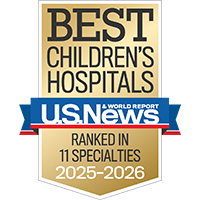Saving future lives
500+ UCSF investigators are researching cures for hundreds of childhood and adult diseases.


In a child with a craniosynostosis syndrome, the bones in the skull fuse too early, causing an abnormal head shape. Bones in the face may also fuse together, resulting in a flat midface and bulging eyes. The skull anomalies can affect eating and breathing and may also be associated with other developmental problems.
There are several different types of craniosynostosis syndromes. These are the most common:
In most cases, children with these syndromes have premature fusion of at least the opening that extends across the top of the skull. But, they may also have early closure of sutures in other parts of the skull and face.
An infant with a craniosynostosis syndrome should be checked right after birth by a nurse from the Pediatric Craniofacial Center to make sure there's no difficulty breathing or eating. Shortly after leaving the hospital, the child should be seen for a full evaluation by the team at the center. These types of skull abnormalities require early attention, although the timing of treatments varies.
A baby with a craniosynostosis syndrome may require multiple surgeries to correct their skull and facial anomalies.
A surgical procedure to adjust the positioning of the bones of the forehead is usually done before the baby is 6 months old.
If the facial bones are fused, a child may need midface advancement surgery. This is a procedure that brings the cheekbones and upper jaw forward to better protect the eyes and improve the child's airway. Because the upper jaw is usually too small, a child with a craniosynostosis syndrome can have an underbite and severely crowded teeth. These are usually corrected with braces, as well as surgical procedures. Timing for the midface advancement and orthodontics is based on a number of factors. They may be done early in life or after growth is completed, depending on the particular needs of the child.
In addition, a child who also has syndactyly, or webbing, of the hands and feet usually requires early surgery to improve their mobility and function.
The UCSF Craniofacial Center – the oldest on the West Coast – has an innovative "one-stop shop" approach to treating head and face conditions, such as craniosynostosis.
There are several health issues often associated with craniosynostosis syndromes. Therefore, it's important that your child also be evaluated by the following specialists:
A child with a craniosynostosis syndrome may encounter social and emotional challenges unique to these syndromes. Ask your child's doctor about available support organizations and resources.
UCSF Benioff Children's Hospitals medical specialists have reviewed this information. It is for educational purposes only and is not intended to replace the advice of your child's doctor or other health care provider. We encourage you to discuss any questions or concerns you may have with your child's provider.

Ranked among the nation's best in 11 specialties
Saving future lives
